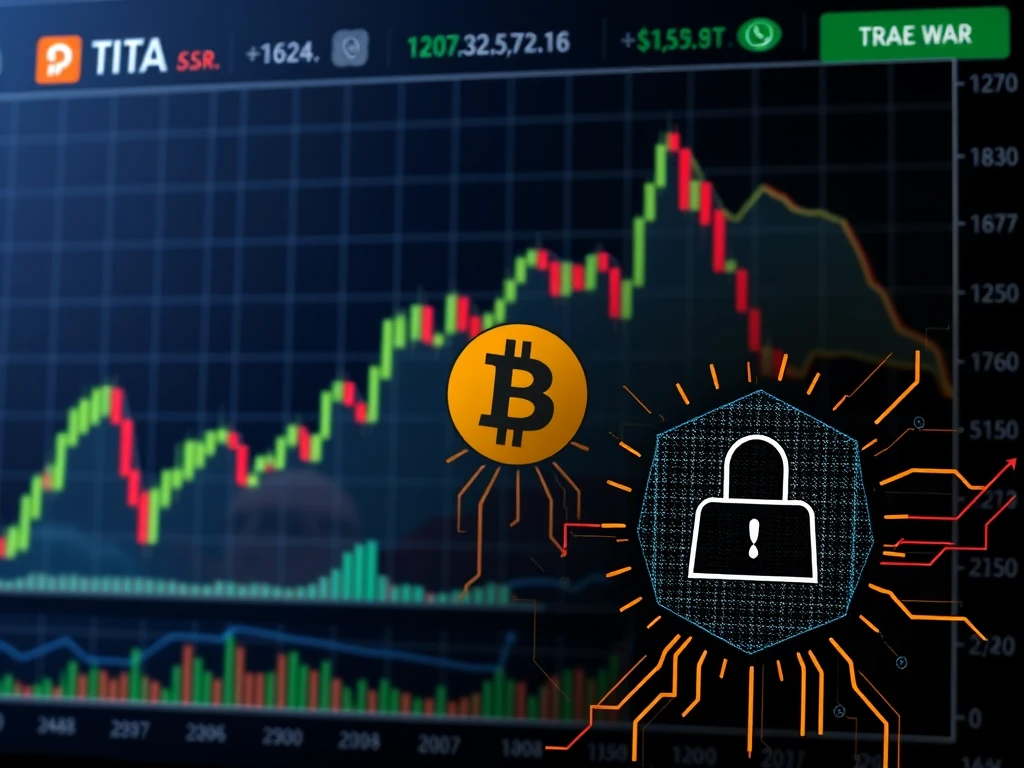Turbulent March 2025: Trump’s Trade War Devastates Bitcoin as DeFi Hacks Expose $22M Losses

March 2025 proved to be a tumultuous month for the cryptocurrency sphere, marked by significant market shifts and security challenges. As we delve into the data, it’s clear that the crypto landscape is navigating a complex web of geopolitical tensions and technological vulnerabilities. Let’s break down the key trends and figures that defined this eventful month in crypto.
Trump’s Trade War Triggers Bitcoin Price Volatility
The first quarter of 2025 witnessed the implementation of US President Donald Trump’s controversial trade policies, sending ripples through global markets, including the crypto sector. The imposition of tariffs on goods from key trading partners like Mexico, Canada, and China created a climate of economic uncertainty. These tariffs, initiated on March 4th, triggered retaliatory measures from China and the European Union, further escalating trade tensions. The fluctuating tariff announcements and delays exacerbated market anxiety, directly impacting the Bitcoin price.
Initially, tariffs of 25% on Mexican and Canadian goods, 10% on Canadian energy, and 20% on Chinese goods were introduced. However, the administration’s subsequent delays and adjustments, including potential negotiable tariff rates per country announced by the US Treasury on March 18th, added to market confusion. This uncertainty directly influenced the Bitcoin price, causing significant fluctuations throughout March.
While Bitcoin price briefly recovered to $88,000 on March 24th, it ultimately slumped to around $82,000 by month’s end, reflecting the broader market unease. The impact of the Trump trade war extended beyond Bitcoin, affecting traditional financial markets and even the crypto investments of the Trump family through World Liberty Financial (WLFI). WLFI’s portfolio experienced mixed results, with several altcoins mirroring the market’s downward trend.
DeFi Hacks Unleash $22 Million in Losses
Adding to the market’s woes, DeFi hacks continued to plague the decentralized finance space in March. While not reaching the record-breaking figures of February’s Bybit hack, a concerning $22 million was pilfered across four separate incidents. These DeFi hacks underscore persistent security vulnerabilities within the sector and raise serious questions about the long-term viability of current security protocols.
Blockchain security firm Lookonchain reported that hackers successfully funneled stolen funds, notably through THORChain, highlighting the sophisticated methods employed by malicious actors. Prominent blockchain investigator ZachXBT voiced strong concerns on Telegram, stating that DeFi is “unbelievably cooked” regarding exploits and hacks. He questioned the industry’s capacity to self-regulate and warned of potential government intervention if security issues remain unaddressed. ZachXBT pointed out that some protocols heavily reliant on fees or volumes from illicit activities, possibly linked to groups like Lazarus, are seemingly neglecting accountability.
Crypto Legislation Gains Traction Across US States
Despite market turbulence and security concerns, there were positive developments in the regulatory landscape. Two US states, Utah and Kentucky, enacted crypto legislation in March, providing crucial definitions for digital assets and blockchain technology. These laws also offer zoning definitions and protections for cryptocurrency miners and establish frameworks for businesses to accept cryptocurrencies. This proactive approach signals a growing acceptance and integration of crypto within state-level economies.
Furthermore, crypto-related bills advanced in 13 additional states, indicating a broader trend towards regulatory clarity. Illinois, Georgia, and Texas are among the states actively considering new legislation. Illinois aims to establish comprehensive industry regulations and consumer protections. Georgia senators are exploring the formation of a study committee on digital assets and AI. Texas, a hub for crypto innovation, introduced multiple bills, including proposals for an oil-backed stablecoin, state investment in crypto, and a blockchain pilot program for state agencies. These legislative efforts represent significant steps towards mainstream crypto adoption in the US.
Solana Ecosystem Revenue Plummets Amid Memecoin Cool-Down
The memecoin frenzy that propelled Solana to new heights earlier in the year experienced a significant cool-down in March. Scandals and investor caution contributed to an exodus from the memecoin space, heavily impacting the Solana network, which hosted a majority of these issuances. Solana witnessed a dramatic 99% decrease in revenue, plummeting from a peak of $15 million on January 19th to a mere $119,000 by the end of March. This revenue decline reflects a substantial contraction in memecoin trading activity.
Decentralized exchange (DEX) volumes on Solana also mirrored this downtrend, steadily declining throughout March. From $3.9 billion on March 2nd, DEX volumes fell to $782 million by the end of the month, indicating reduced on-chain activity and fewer daily active addresses. Despite the memecoin market correction, Synthetix founder Kain Warwick offered a positive outlook, highlighting the infrastructure improvements driven by the memecoin speculation. He stated that “Solana as a chain is 100 times better than it was pre-memecoin,” suggesting long-term benefits despite the short-term revenue dip.
Looking Ahead: Liberation Day and Regulatory Debates
March 2025 concluded as a challenging month for the crypto market, characterized by Bitcoin price volatility triggered by the Trump trade war and the persistent threat of DeFi hacks. Major cryptocurrencies largely traded sideways or experienced losses, with Ether (ETH) notably down 18% for the month. Economic uncertainty loomed large with the introduction of new tariffs from China and the EU.
The crypto market braces for further tests in April, particularly with “Liberation Day” on April 2nd, when mass tariffs threatened by President Trump are scheduled to take effect. However, past policy reversals suggest the actual impact may be less severe than initially anticipated. Additionally, the US stablecoin law is set for debate in the House Financial Services Committee in April, a development widely regarded as crucial for crypto’s growth in the US. Furthermore, the sentencing of Avraham Eisenberg, convicted in the Mango Markets DEX exploit case, on April 18th adds another layer of anticipation to the coming month.
Despite the rocky terrain, the crypto industry’s resilience and continued development remain evident. International crypto conferences continued to draw participants, and legislative progress in various US states offers a glimmer of optimism for future growth and stability. The coming months will be critical in determining how the crypto market navigates these intertwined challenges and opportunities.








